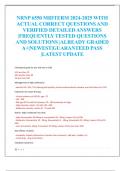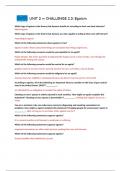NRNP 6550 MIDTERM 2024-2025 WITH
ACTUAL CORRECT QUESTIONS AND
VERIFIED DETAILED ANSWERS
|FREQUENTLY TESTED QUESTIONS
AND SOLUTIONS |ALREADY GRADED
A+|NEWEST|GUARANTEED PASS
|LATEST UPDATE
Cholesterol goals for pt's with dm or CAD
LDL less than 70
HDL greater than 40
TG less than 150
Management of high cholesterol
- identify LDL, HDL, TGs (fasting lipid profile), clinical artherosclerotic disease, and risk factors for CHD
Indications for statin therapy
- clinical evidence of ASCVD, age <75
- LDL >190
- DM age 40-75 with LDL between 70 - 189 (moderate to high)
- High intensity: adults >21 with LDL >190
- Moderate intensity: adults 40 - 75 with DM
Statins: high/ moderate/ low dose
- High: Atorvastatin 20-40mg or rosuvastatin 20 - 40mg. Lowers LDL by 50%
- Moderate: Atorvastatin 10 - 20mg, Rosuvastatin 5 - 10mg, Simvastatin 20- 40mg. Lowers LDL by 30 -
50%.
- Low: Simvastatin 10mg, Pravastatin 10-20mg. Lowers LDL by less than 30%.
Side effects of statins
- myopathy, hepatic dysfunction (monitor liver enzymes!), abd pain, rhabdo, n/v
- many drug - drug interactions
metabolic syndrome
1|Page
,- 3 of these signs:
abdominal obesity
triglycerides > 150mg/dl
HDL <40 (men), <50 (women)
BP >130 syst or >85 diast
fasting glucose >100
Treatment of metabolic syndrome
Treat underlying causes
Treat HTN
Aspirin for pt's with CHD
Treat elevated triglycerides or low HDL
Treatment of elevated triglycerides
- weight management, physical activity, avoid alcohol
- treatment DM
- reach LDL goal first. If still elevated triglycerides, then condider adding LDL lowering drug
- if triglyceride level greater than 500mg/dl, avoid pancreatitis! By: low fat diet, weight management,
start omega-3- fatty acids or niacin
Risk factors for a myocardial infarction
CAD
HTN
Metabolic syndrome
obesity
smoking
DM 1 & 2
male
family hx
Time guidelines for STEMI
Door to fibrinolytics: 30min
Door to angioplasty: 90min
Types of Angina
Stable: intermittent pain (with exertion) lasting 1-5min, nitro may help, control with lifestyle changes
and nitrates, beta-blockers, calcium channel blocker. St depression on ECG.
Variant/ prinzmetal's: pain in rest (cor artery spasm so no atherosclerosis!) lasting up to 30min, manage
with calcium channel blockers. ST elevation on ECG.
Unstable: pain lasting longer than 30min, pain may radiate, nitrates do not relieve pain, manage with
ACS protocol
ECG changes for unstable angina, NSTEMI, and STEMI
2|Page
, US and NSTEMI: ST depression.
STEMI: ST elevation
signs of MI progression: peaking of T waves, diminished R waves
Ischemia: T wave inversion, peaked T waves, ST depression
Injury: ST elevation greater than 1mm
Infarction: Q waves greater than 25% of QRS complex
Expected site of infarction based on ECG changes
Inferior: leads II, III, AVF
Inferolateral: II, III, AVF, V5, V6
Anterior: V3 and V4
Anteroseptal: V1, V2, V3
Posterior: V1 and V3
Right ventricular: V4R V6R
Cardiac enzymes: which and timing
troponin, increases after 4-6 hrs
myoglobin, increases after 2-3 hrs
CK-mb, increases after 4-8 hrs
Emergency management of ACS
First 10min:
Aspirin 162-325 PO (plavix for allergy to aspirin)
Nitro 0.4mg subli q5min (morphine 2-4mg q5-15min if unrelieved by nitro)
O2 at 2-4ltr/min
monitor vitals
IV (cardiac enzymes and other labs drawn)
pain assessment
ECG within 10min
xr chest
For STEMI:
start reperfusion therapy (PCI/ fibrinolysis)
After admit:
trend cardiac enzymes
start betablocker for hemodynamically stable patients (25-50mg PO, end with 50-100mg PO BID)
Optional for unastable angina/ high risk ischemia/ NSTEMI:
hep. drip, to maintain PTT between 1.5 - 2
nitro drip to control pain
consider need for PCI/ PTCA or CABG
3|Page





